James Langan
Copyright James Langan/RoadTraveler. All Rights Reserved
Resource:

Trucks, Tech, Reviews, ADV Travel
James Langan
Copyright James Langan/RoadTraveler. All Rights Reserved
Resource:
Rancho 9000 shocks have been on several of my trucks over the past 20+ years and I still like them. They are much better than the factory dampers, and adjustable, which can be pretty fantastic for trucks that are often lightly loaded, and/or heavily loaded.
Want to go fast, then maybe a race-inspired shock is your solution? Got a heavy load, a less sexy (and less expensive) heavy-duty damper might work.
James Langan
Copyright James Langan/RoadTraveler. All Rights Reserved
Resource:
This article was published in my Turbo Diesel Register column, Still Plays With Trucks, last quarter of 2017. Dodge/Ram pickups were used for the examples, but the fundamentals are the same, regardless of the car or light-truck brand.
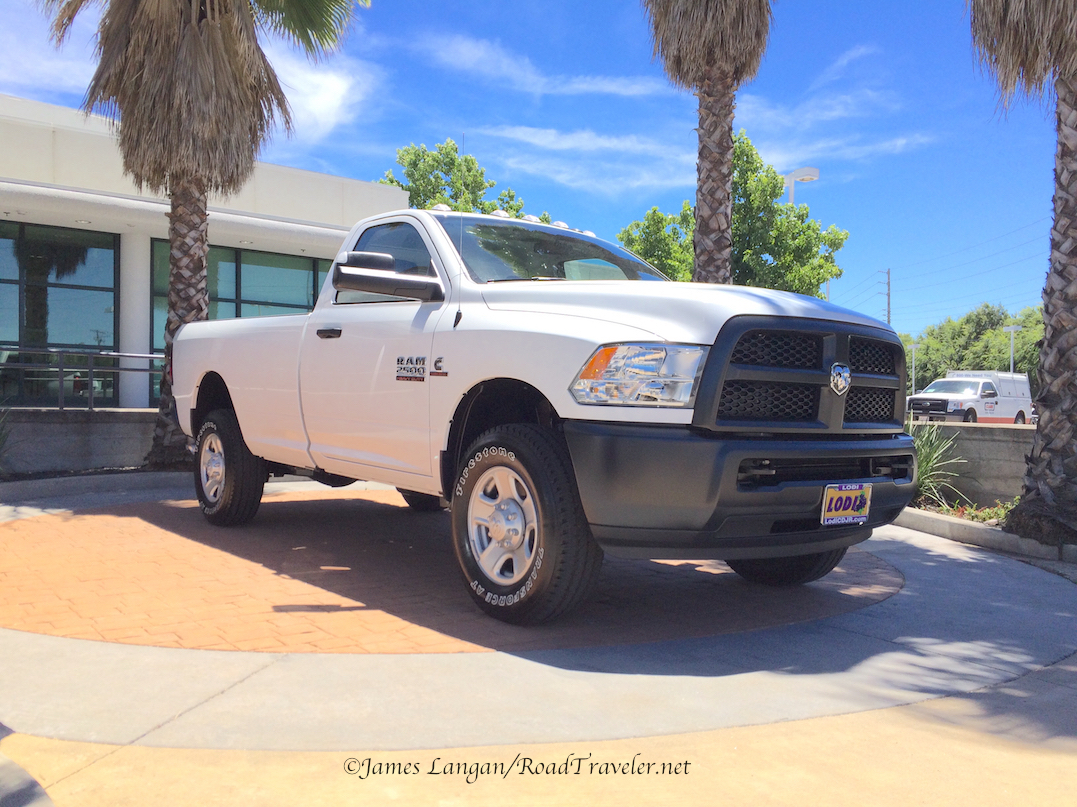
Sticker Shock?
Editor Patton shared that there is occasional, maybe even constant, grumbling from some readers about the cost of new trucks. Of course finances are a private matter, and certain folks have more money and/or better credit opportunities than others, but my perspective is that of a working-man. For 37 years I’ve held blue-collar, tradesman, or professional jobs, and my current vocation, journalism, is judged as a meager living for most if it’s their sole source of income.
One popular (and likely true) statement is that new trucks cost as much than some folk’s first houses. There are possible retorts: bet their current house is valued much higher than their first; the first home had fewer appliances and gadgets; new(er) trucks have more stuff than older luxury cars.
Even in 1996, I would rather drive my new F-350 on long trips than the 1979 Mercedes-Benz 300SD we also owned, my wife’s daily driver at the time. Time marches on, whether we like it or not, newer machines are often nicer.
It’s not news that fancy trims and optional features cost money, both in houses and vehicles; if we want extra gadgets and bling we will have to pay for them. That said, is a new Ram Tradesman really out of the question? Should we reconsider what we require and value?
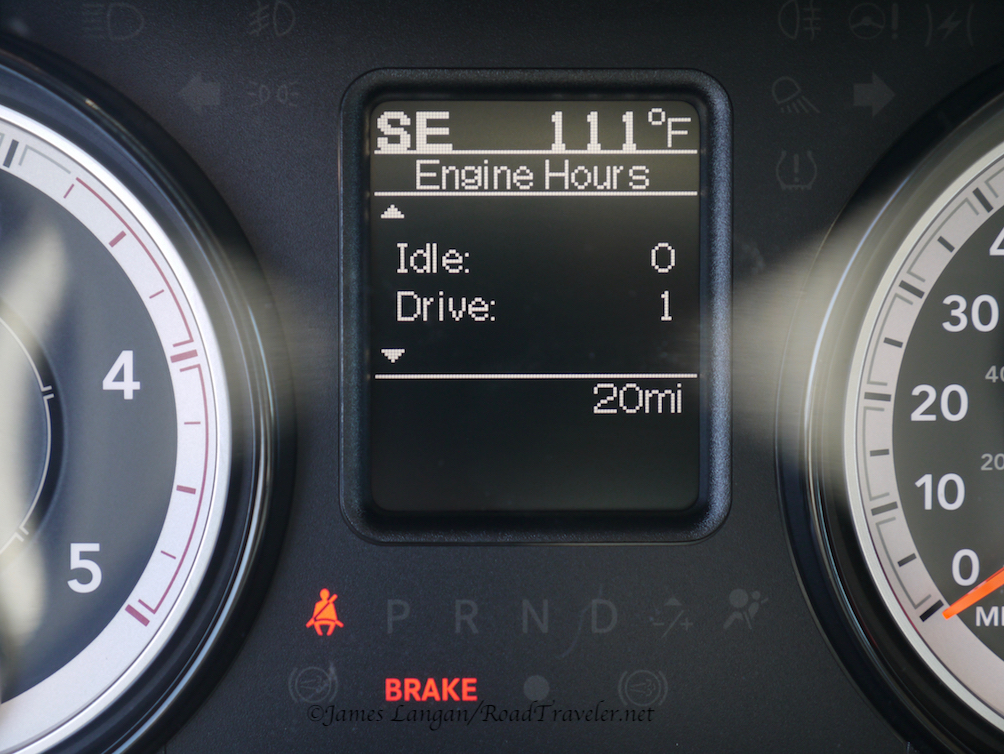
Consider a Tradesman
Since rejoining the TDR staff three years ago, I’ve shared that my 2014 Crew Cab Tradesman is impressively nice, not stripped in any historical sense of the word, and I like it just as much now after logging 50,000 miles. Top-of-the-line options two decades ago are standard on modern platforms. Need a specific example?
My 1996 Ford F-350 crew cab, with a 7.3L diesel, was an XLT, the highest trim offered by Ford at the time (brand doesn’t matter, they are comparable and competitive, then and now). It had power windows and locks, A/C, cruise control, cloth seats, carpeting, AM/FM cassette stereo, plus a couple of uncommon commercial features I ordered. The only notable items that F-350 was missing were keyless remote and an automatic transmission.
My 2014 Ram Tradesman has everything the ’96 Ford had (except the cassette player) plus satellite radio, an informative/interactive EVIC display, abundant torque and horsepower, an exhaust brake, stability and safety systems, higher GVWR/GCWR, rides better empty and loaded, is quieter inside and out, more comfortable, has much longer service intervals, etc. The F-350 cost me $30,000, which was $500 over dealer invoice, not including taxes or registration.
Using a consumer price index (CPI) calculator to adjust for inflation, $30k in May 1996 is equivalent to $45,600 in June 2014 and $46,900 in June 2017, months when I bought new Rams. Interestingly, I didn’t have to pay that much for either of them. I actually paid thousands less for both. Want to know how I did it? First let’s compare apples and pears.
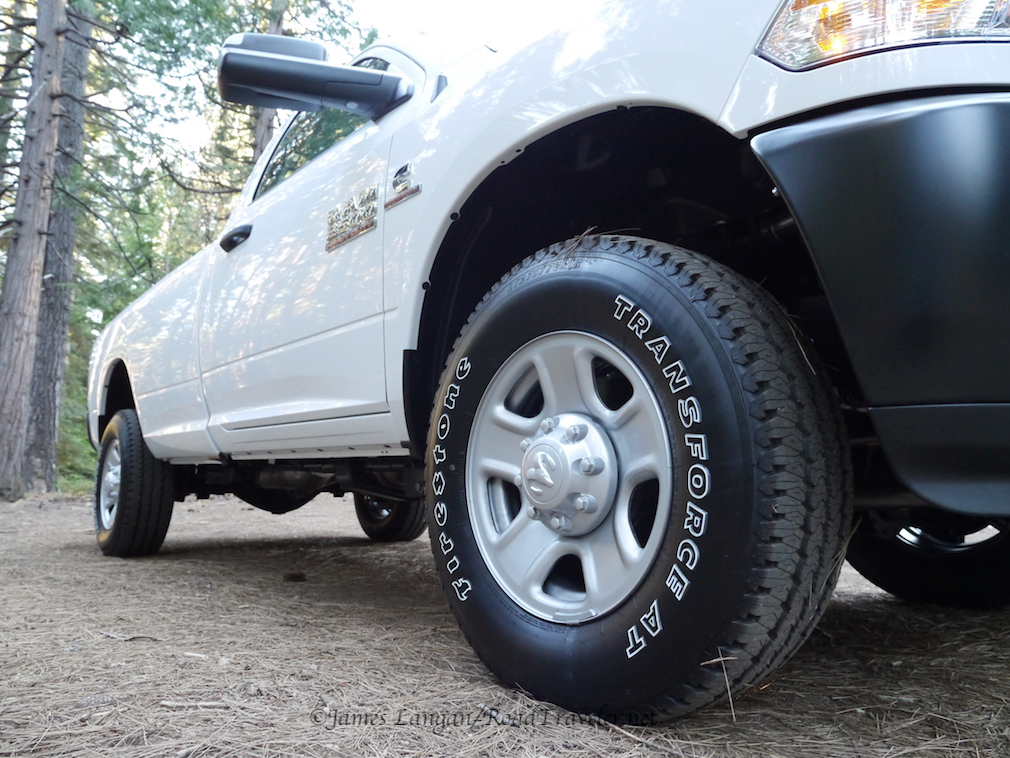
2017 Ram Cummins 2500 4×4 6.4’ Box
Regardless of the moniker on the side, a Tradesman drives as well as a Laramie, the chassis is the same. Seating, a few ergonomics, and other high-end features may differ, and everyone must decide for themselves if they want, need, or require those extras and are willing to pay for them. Some things, like seats, can be upgraded after a purchase. It’s easy to say fancy trucks are expensive, but how big are the steps between models?
There is nothing like a graph or table to drive-home a point. In August 2017, using my local Nevada zip code and NADAGuides.com, I researched the base Invoice and MSRP prices for six 2017 Ram 2500s. All were 4WD crew cabs with a 6.4-foot box. To show the raw difference between trims, only one option was added to each truck, the expensive 6.7L Cummins engine that TDR readers care about. According to NADA, a manual transmission is still standard up through a Laramie, but good luck finding one on a dealer’s lot if that’s what you prefer. Longhorns and Limiteds are only made with the 68RFE tranny. (Ram no longer offers a manual transmission heavy-duty truck.) All figures include the $1,395 destination fee that FCA charges for delivery. If you start banging on a calculator, it’s interesting to see how much extra the luxury cost. From a Tradesman to a Laramie there is an MSRP jump of $11,800, then another $10,430 for a Limited. Is a Limited $22,000 nicer than a Tradesman? For some folks the answer is a resounding yes. Others may decide they’d rather spend that $22k on other toys or upgrades, or maybe not at all.
Table One
| ’17 Ram 2500 CC 4×4 6.4’ | Invoice | MSRP |
| Tradesman | $46,069 | $49,140 |
| SLT | $50,633 | $54,240 |
| Bighorn | $52,297 | $56,120 |
| Laramie | $56,622 | $60,940 |
| Longhorn | $62,647 | $67,670 |
| Limited | $65,922 | $71,370 |
Learn How To Buy A New Vehicle
Obviously a Tradesman costs much less than a Limited, but you can purchase almost any new car or truck for much less than MSRP. It’s not easy to put decades of experience into an article, and some things are difficult to teach from afar, but this is my crash course. The goal is to buy a new vehicle for a low price, quickly, and with limited hassles. It helps if you have experience and confidence, but there is only one way to get those, you have to earn them.
Supply And Demand & Other Fundamentals
The economic laws of supply and demand are real. Some stores may be willing to sell a particular machine for much less than a similar one for a variety of reasons, including the time they have been making payments on it (flooring), the model, and how hard it might be to procure a replacement. Generally, it’s much easier to negotiate a low price for a new rig because the dealer’s invoice, essentially their cost (read on), is readily available. Negotiating for used cars is trickier because the investment is not published, and they are not going to share that information to make your job easier.
Unless you are paying cash, or bringing a check from your bank or credit union, financing options and/or trade-ins may complicate and affect any negotiation. People who think they are going to buy a new vehicle for an extremely low number, while also getting top dollar for a trade-in, are only fooling themselves. It ain’t goin’ to happen. If you insist on a high trade-in value (dealers will rarely pay more than wholesale book) those monies will be made up elsewhere, likely in the price of the new machine. That is why knowing in advance how you are going to pay for your new ride, and whether or not you have a trade, is important to all involved, before getting down to the nitty gritty.
Invoice Not MSRP
Many people negotiate from MSRP down. That is wrong. You should work from invoice, up or down. Invoice prices are online, you just need to insure you have every order code selected, or deleted, so you are comparing the same exact model with the same options. When you feel conformable you can ask for the invoice, politely and with confidence. People do it everyday.
Cost not payments. You should focus on the cost instead of your payment. The payments will always be lower for a given term and interest rate if you finance less. That math can and should be done, but talking about payments is the wrong way to negotiate, similar to working down from MSRP. If you have money and/or excellent credit, you are in the driver’s seat. Once you realize that and learn how to navigate the waters of car buying, it will become fun or at least less hassle.
Long distance helps. Do your negotiations over the telephone or by email when possible. Knowing the vehicle you might want, when, and how you are going to pay for it, puts you in a strong position, and should greatly simplify and accelerate the processes. I’ve located my last four new 4WDs online, either using the manufacturer’s or dealership’s online search engine. Other sites work well too. Once located, I call (or email), speak with a manger who has authority to set a price (sometimes you must talk with a salesperson), introduce myself, state where I’m calling from, the exact vehicle I’m considering (stock number or VIN), and discuss the terms of the possible sale. For the inexperienced, $500 over invoice is often a good place to start. With experience this can take just a few minutes.
17 Ram 2500 window sticker copy
Negotiating over the telephone (or email) can help many make better decisions. Not being on a car lot can prevent impulsive action. Be an intelligent, calculating shopper, not an emotional one. You can be thrilled or excited, but this is a business transaction. Save the happy dance for later. A few dealerships won’t discuss pricing over the telephone. That’s fine, others will, don’t waste your time.Willingness to travel increases the opportunities to negotiate and the selection of rigs that might fit your criteria.
It’s very simple to make a deal slightly above or below invoice, not including any rebates, if you remove the complexity of a trade-in. Manufacturer rebates are yours to apply to the transaction, and it’s helpful to remember the obvious, that they come from the manufacturer not the seller. Negotiate your price without them, they will come off the bottom line, later, after an agreement is reached.
When it gets close to the end, and you have most of the figures compiled, be sure to inquire about the document fee (doc fee). One might argue that this is an example of the seller charging you for their cost of doing business, and in a sense that’s true. However, doc fees are not going away, and some are reasonable, like under $100. Others are hundreds and seem ridiculous. Many states regulate the maximum fee for this service. If the doc fee is too high, you don’t have to trade with that store, but remember to step back and view the big picture. A high doc fee may be acceptable because of the price you negotiated.
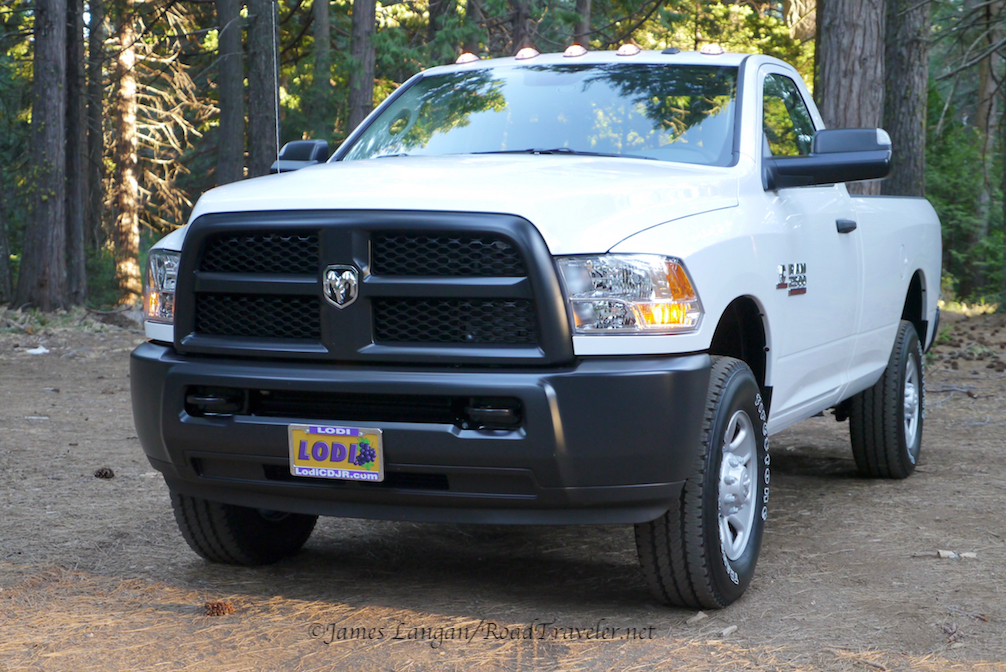
Dealer Holdback, Profit, And Commissions
Dealer holdback, or just holdback, is essentially a rebate for the franchise from the manufacturer that is built into the pricing. Depending on the brand it may be a percentage of the MSRP or invoice price or even a flat dollar amount. You will not see it listed on NADA or Kelly Blue Book, but it’s in there. If you are allowed to see or are given a copy of the actual document during your negotiations, and know where to look, you may see the number or be able to calculate the figure. The intent of holdback is to inflate the apparent dealership cost, help offset sales commissions, and increase profits overall.
Holdback is considered off limits during most negotiations, but again supply and demand are factors, as is your car-buying expertise. Understanding holdback helps explain how stores can sell cars at, or below invoice, and still turn a small profit to stay in business. When you find a truck advertised for an extremely low price, the dealership may need to move that specific vehicle and are willing to dig into or go below their holdback.
Typically automotive salespersons are paid a commission, often 25–30% of the profit, which is generally defined as the difference between dealer invoice and the selling price above invoice. If you are able to buy a new truck for $500 over (aka a nickel over), the salesman’s 25% commission is $125. That’s not much for the amount of time and effort involved, and sometimes days pass without a single sale. Of course, if you pay MSRP (or more) for a Limited, the commission may be over $1,300. One way to compensate for smaller commissions is with higher sales volume, and this is actually the business model for certain franchises.
There are many variables, and some sales are very profitable, but several dealerships operate on lower profit margins these days. For an example of a low profit sale, let’s use the SLT listed in Table One. One-percent above the $50,633 invoice number is a mere $506. That’s a fantastic price for a buyer but not much for the seller or salesman. There may be other dealership incentives and promotions from the manufacturer, like monthly, quarterly, and yearly sales competitions, but those extras don’t always materialize and can’t be counted on to sustain the business.
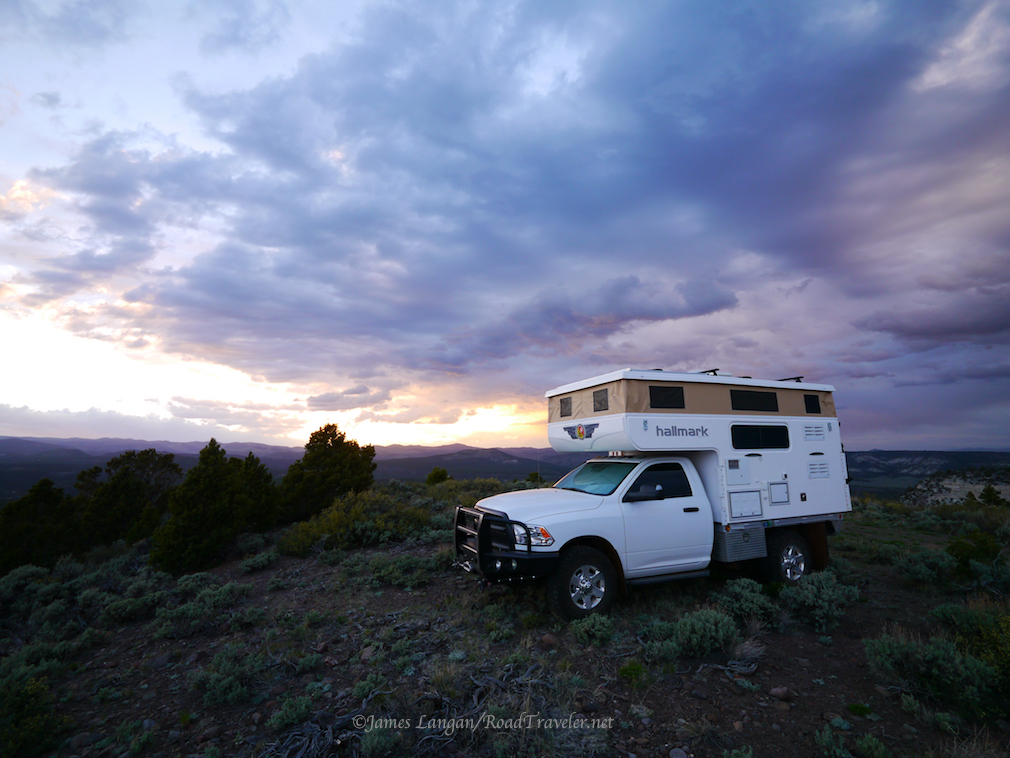
Extended Warranties and Service Contracts
Warranty and service contracts are typically sold by the finance and insurance (F&I) department; they are also subject to negotiation. The problem is, like with used cars, you don’t know the cost, and generally there is a fair amount of profit in these contracts. Even when folks negotiate a good deal on a new rig, they may be worn down by the time they get to the F&I office where the actual purchase paperwork is completed. If you say no thanks, similar contracts may be offered later.
These are reasonable and desirable services for many, as they don’t want to maintain or repair their own vehicles. If anything fails, they want to take it to their local store and want it covered. Cool, but read the fine print, there are always a few (or several) exclusions, less with the more expensive policies. If you prefer to work only with a dealership, and many do, then buying a manufacturer-supported contract may be for you. If not, credit unions sell similar products, typically at much lower prices.
Want my take? I never purchase these services, but I also do most of my own work, make modifications that could cause a warranty claim to be rejected, and generally have vehicles paid-off before the standard warranty expires. I have a friend that has bought a few nice used cars, always gets an extended warranty through his credit union and has needed them for major things, including a transmission. There are two sides to every coin, and it’s your call.
Additional Sense About Dollars
Since 2006, I’ve bought four new 4WDs, two Toyotas and two Rams. The 2011 Tundra cost me $800 over invoice, because of less supply and more demand. Eight-hundred over is not a bad price, and many would do well to make a similar deal, particularly if negotiated quickly and easily over the telephone. The $3,000 in manufacturer rebates came off the bottom line, essentially covering the sales tax. The other three were between $500 and thousands under invoice, supply and demand mattered. You must put in the legwork; there are bargains to be had, and rebate incentives can be generous. Consider a Tradesman; if you want a fancier truck, you might be able to get one for much less than you thought, maybe just slightly above invoice. Good luck and enjoy your new ride.
James Langan
Copyright James Langan/RoadTraveler/Turbo Diesel Register. All Rights Reserved.
A version of this article was also published in the Turbo Diesel Register magazine.
At the NW Overland Rally in June, I saw this Delxo three-step aluminum ladder outside a Four Wheel Campers Hawk flatbed. It’s light and super slim when folded.
The Louisville shelf-ladder mounted to the rear of my AT Overland can carriers is great once camped, however for brief roadside stops it’s not convenient to unbolt to help my wife get into our Hallmark flatbed camper. (The White Knuckle Off Road Products Hitch-Step works for me most of the time.)
The heavy-duty folding Louisville ladder is shown for comparison. It’s a fantastic shop ladder (and expensive), though far too big and heavy to mount on, or put inside the camper.
The Delxo seems rounded enough that I think interior cabinetry damage is unlikely on decent roads. If we really like the Delxo ($80 from Amazon) I may think about some cushioning cabinetry protection inside our Hallmark Nevada flatbed.
Tell ‘em you saw it on RoadTraveler.net.
James Langan
Copyright James Langan/RoadTraveler. All Rights Reserved
Resources:
White Knuckle Off Road Products
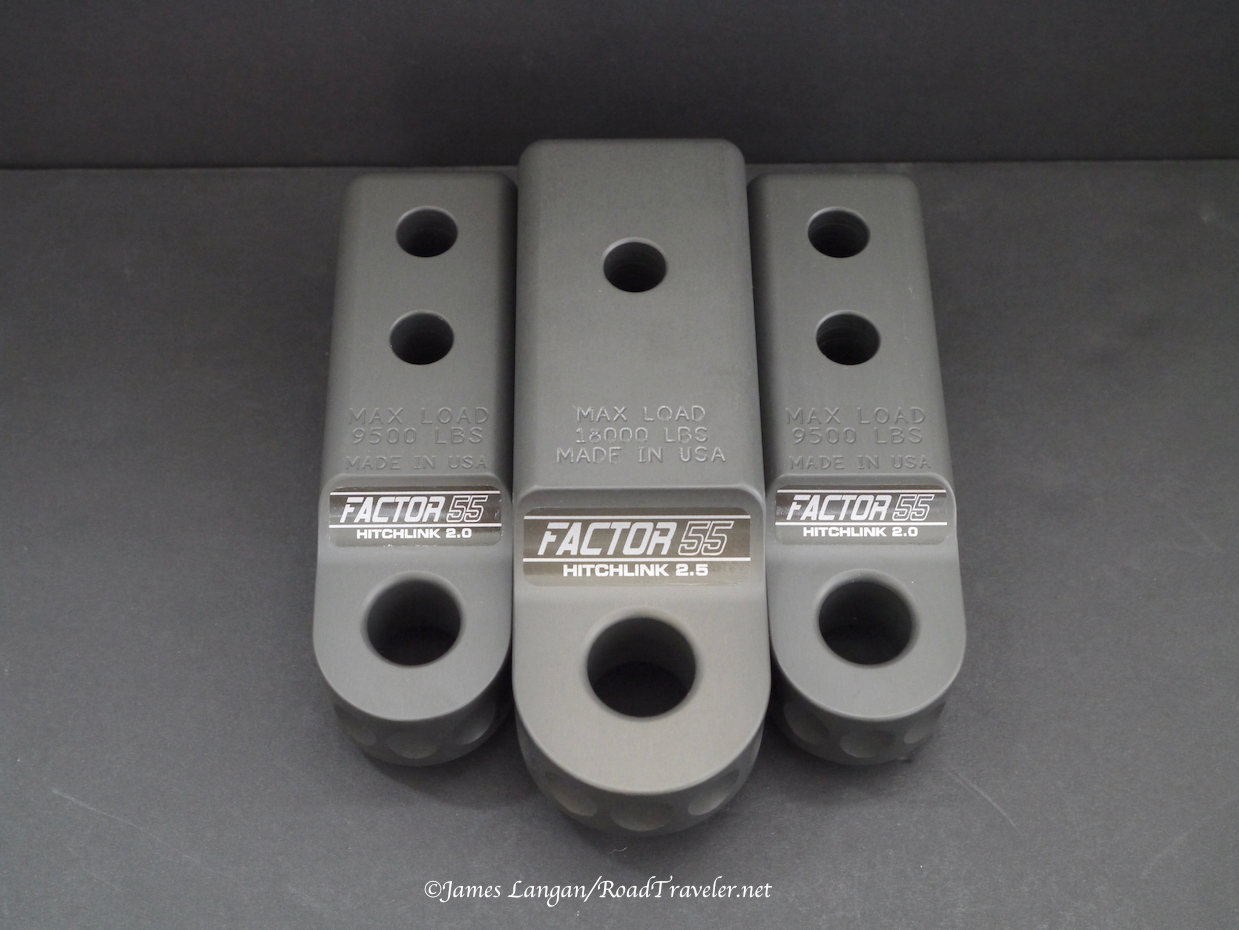
The founder and man at the helm of Factor 55 is an engineer with an aerospace background who creates and tests everything right here in the USA, at Boise, Idaho. Factor 55 continues to design and manufacture what are arguably the best Closed System Winching™ and recovery products available. Cutting-corners, and making stuff cheaper or offshore is not an option.
Filling the Pack Mule’s two hitch receivers on the front Buckstop Truckware bumper are two Factor 55 HitchLink 2.0 recovery shackle mounts to facility vehicle recoveries. Key features include:
– Using a receiver as a recovery or tow point
– Lightweight precision CNC machined 6,000 series aluminum
– Weighs only 1.9 pounds. Steel versions weigh up to 8 pounds
– Rated at 9,500 pounds
– Ultimate failure at 51,000 pounds
– Fits standard 2-inch receivers
– Fits common ¾” screw pin shackles/D-Rings
– Anodized or powder coated for oxidation protection
– $80
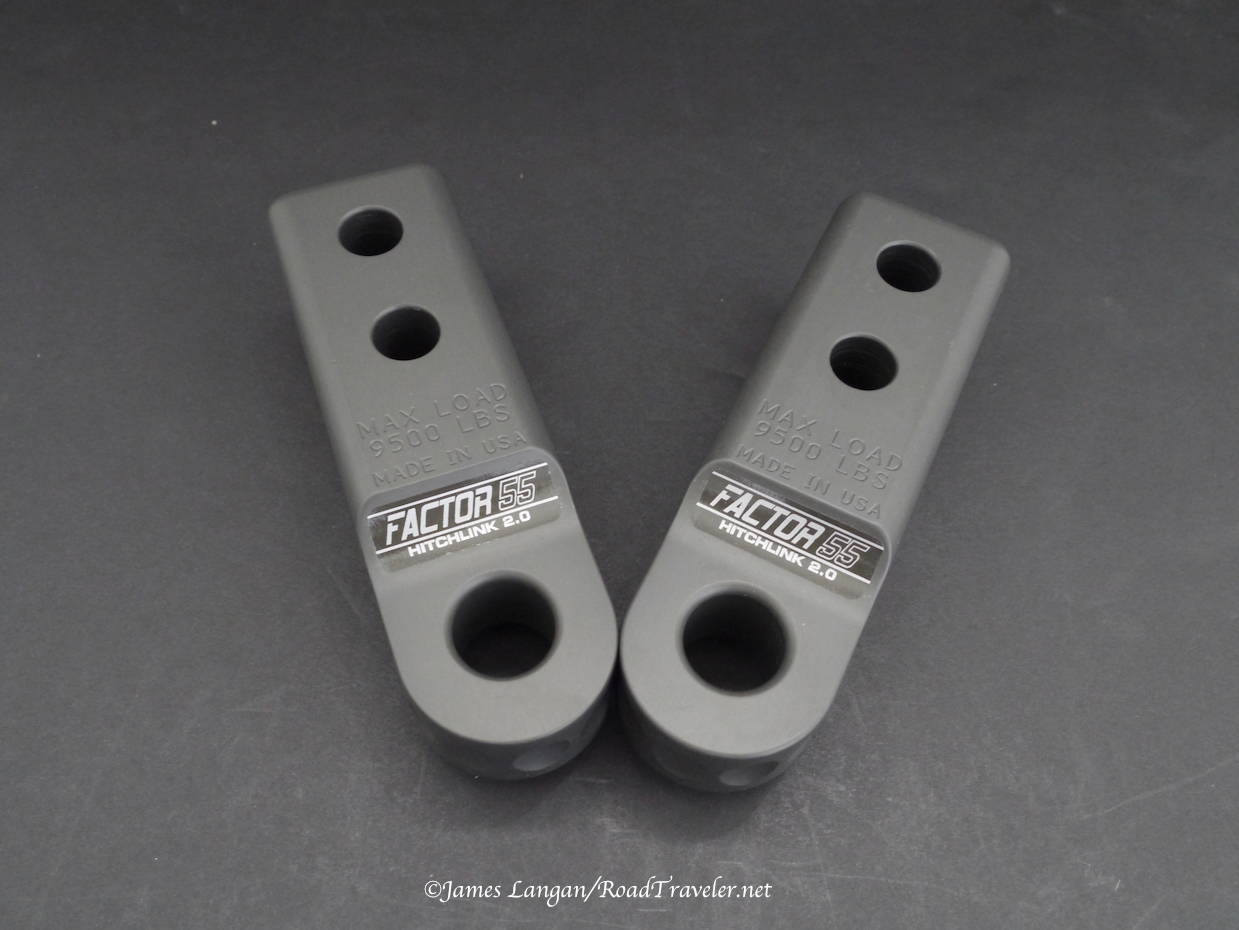
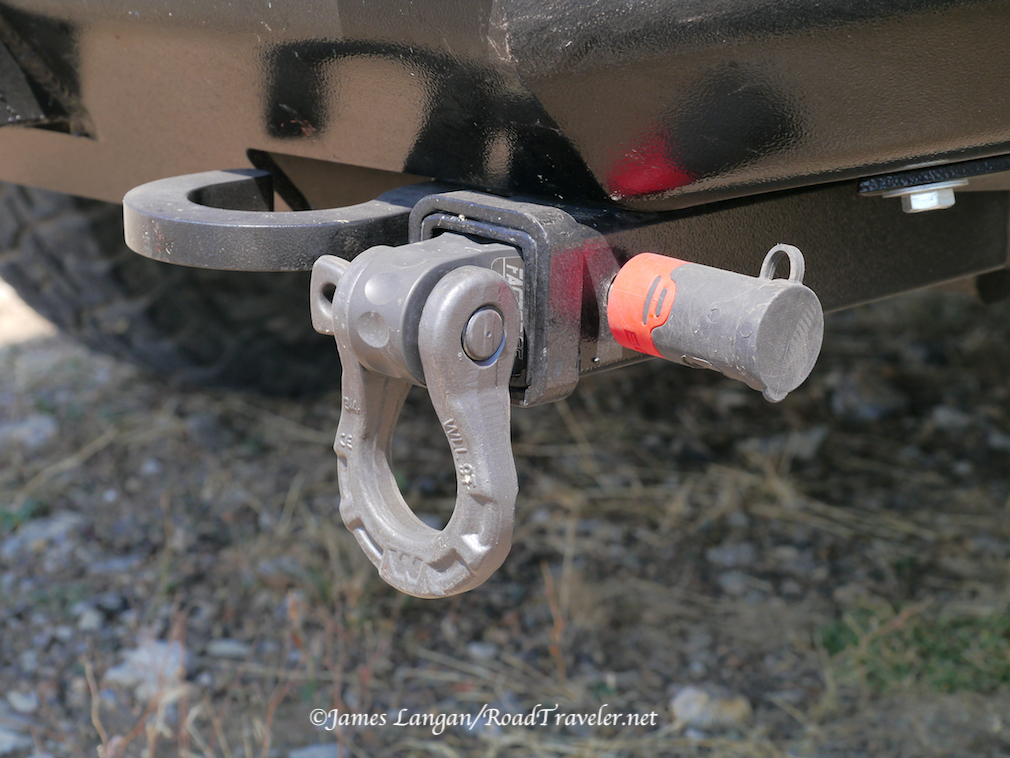
Oscar The Pack Mule retains the factory Ram 2.5” receiver in the rear, so for the first time I am able to use Factor 55’s HitchLink 2.5 product in the back. Additional features of the HitchLink 2.5 include:
– Will accept both ¾” and 7/8” shackles
– Can be oriented inside the receiver, vertical or horizontal, depending on need
– Eliminates a receiver sleeve to downsize and downgrade a receiver to 2”
– Rated at 18,000 pounds, with Ultimate Failure at 69,000 pounds
– $120
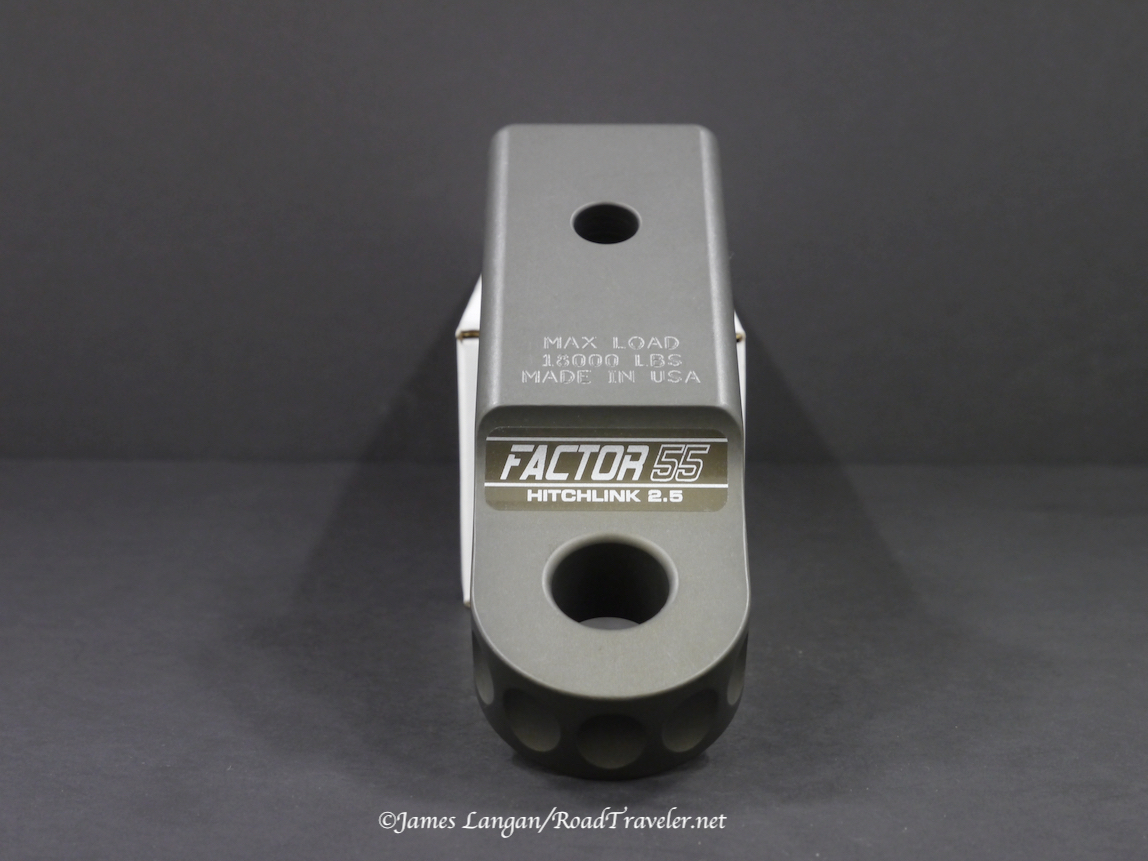
The FlatLink MultiMount ($200) was introduced at the 2017 SEMA Show, but it took me one year to add this fantastic winch line shackle mount to the end the Pack Mule’s Warn synthetic rope. With few exceptions, the hooks supplied with otherwise top-quality winches have been substandard since the introduction of recreational self-recovery winches. According to Factor 55, many are only rated for a working load of 4,000 pounds and will fail around 16-18,000 pounds, though some let go as early as 11,000 pounds. Yikes! (The EPIC Hook on my Warn M16.5ti-S was rated for 18k.)
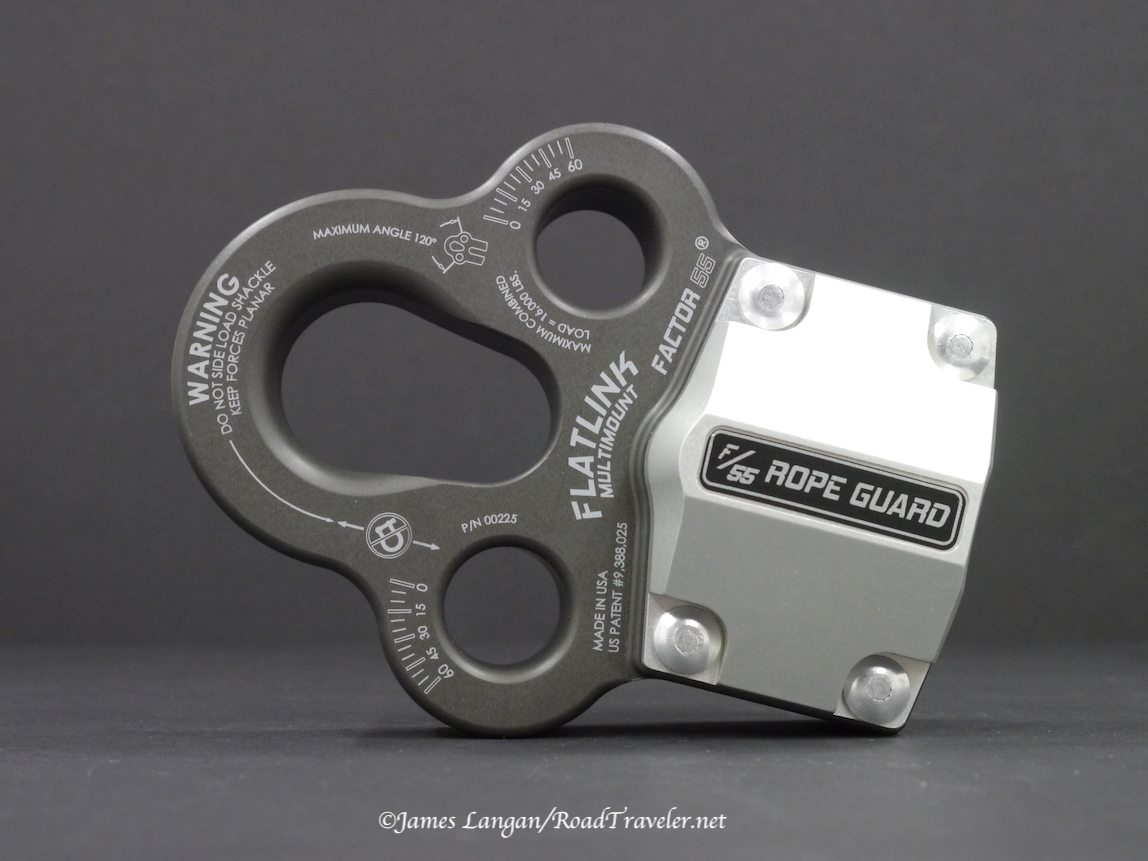
All of Factor 55’s shackle mounts correct the common hook deficiency, while also facilitating Closed System Winching™ techniques for additional safety. My MultiMount was ordered with the optional Rope Guard ($50), which protects the synthetic rope from impacts, abrasions, and UV exposure. Features unique to the FlatLink MultiMount include:
– Designed for difficult off-camber vehicle recovery scenarios, where two different winch pull directions are often necessary
– Oval Hole opening connects to the pin ends of 7/8” and 1” screw-pin shackles
– Two additional shackle pin-mounting holes provide secure shackle attachment points for multiple pull directions. The center hole provides a secure conventional center pull shackle mount point eliminating shackle side-loading forces at the MultiMount interface
– Winching with a bridle arrangement is possible by using the two outer shackle pin mounting holes in combination with common bridle rigging
– The MultiMount may be folded flat against fairlead surfaces when stowed, resulting in minimal impact to vehicle approach angles
– Maximum Load: 16,000 pounds
– Ultimate Strength: 40,000 pounds
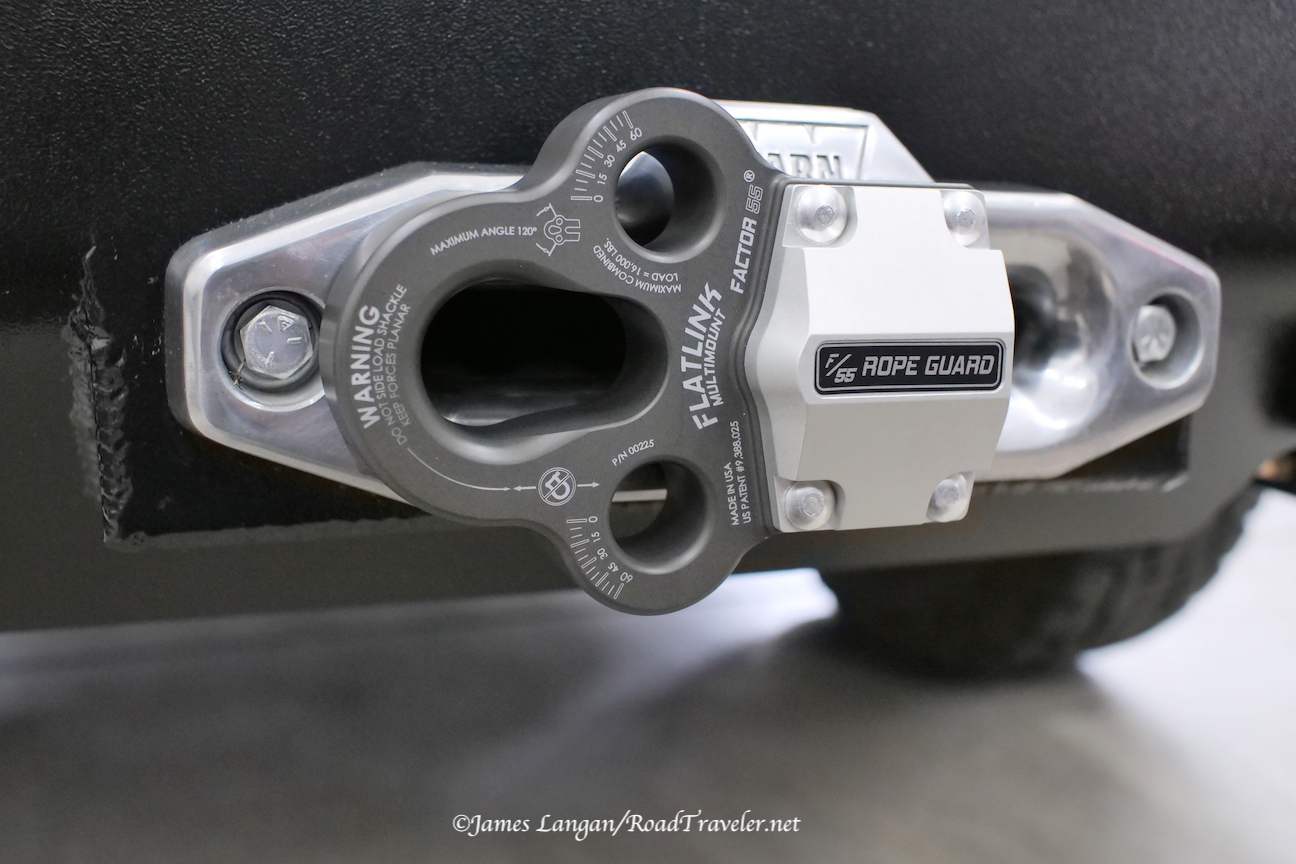
Tell ‘em you read it on RoadTraveler.net.
James Langan
Copyright James Langan/RoadTraveler. All Rights Reserved
Resource:
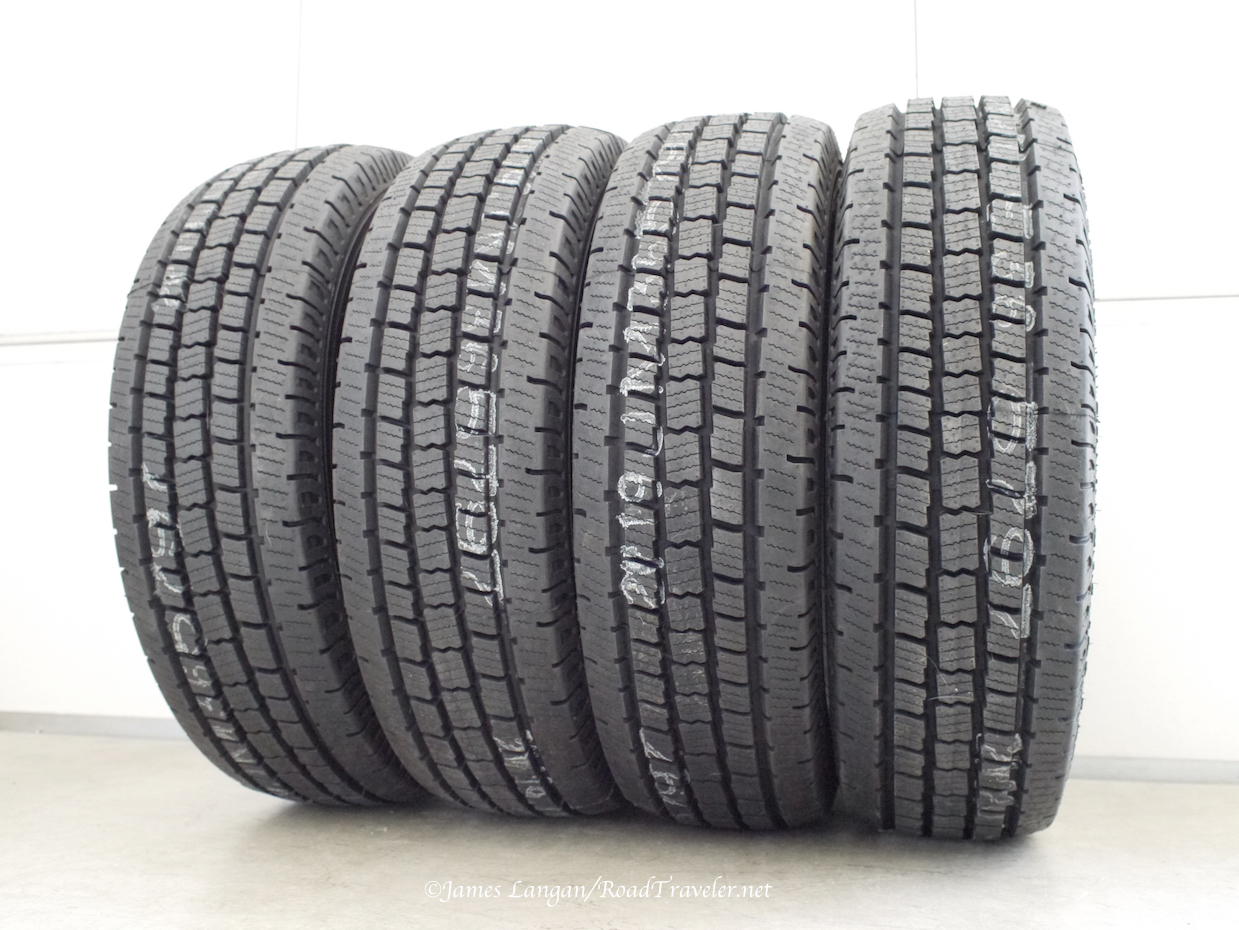
Cooper Discover HT3, LT 235/75R15 For A Vintage Travel Trailer
Automotive tire tread-separation failures are presumably at record historical lows due to the quality of modern tires, and the advent tire pressure monitoring systems (TPMS). I’m not a fan of how TPMS systems have been implemented on late-model heavy-duty Ram 2500 trucks—which require 60 psi in front and 80 psi in the rear to avoid a dash-light and flashing EVIC display—yet having psi information available while driving is a huge safety feature. The TPMS amber warning light helps alert the average, possibly inattentive driver that they have a tire that has dropped below the psi specified by a manufacturer. Like them or not, TPMS are surely here to stay, however there is no legal requirement to monitor pressure on trailers.
Trailer tires are probably ignored more than those on cars and light-trucks, and that’s saying something because many drivers give their automotive tires zero attention or maintenance until there is an obvious problem. I can only offer anecdotal evidence, but I observe far more trailers on highway shoulders with obvious rubber failures than tow-vehicles. A quick search for factual data about these trailer failures didn’t produce scientific charts I could quote, though there were plenty of links to articles and posts about trailer tire failures and how to avoid them. There was a common thread among them, which helps corroborate my experience and traditional advice: buy enough tire and don’t exceed the rated capacity.
Many trailers are used infrequently, whether RVs, utility trailers, or seasonal boat trailers, and it appears many owners fail to ensure tires are appropriately inflated and ready to travel. If pressures are not checked and adjusted to proper levels before a trip, particularly during the hotter months, tires can be easily overloaded; this will cause overheating, which can lead to separation failures. Trailer tires are also often left to rot in the sun, which contributes to aging before they see many miles.
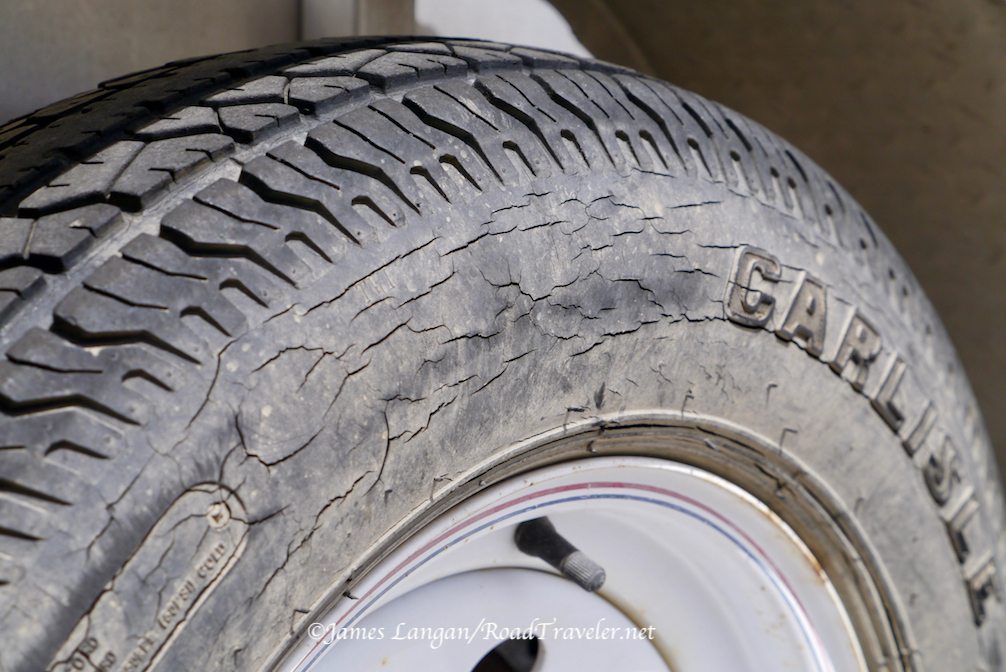
Needed RV Tires
Our vintage 1978 Avion travel trailer has served us well for the past 24 years and has consumed several sets of rubber. In addition to the miles traveled, bias-ply tires and the independent suspension have sometimes contributed to rapid wear. The Avion’s Adjust-A-Ride suspension helps the trailer ride and tow well, but there is limited adjustment available to insure perfect wheel alignment.
Like Ford’s Twin I-Beam and Twin Traction Beam (TTB) suspensions on older F-Series trucks, camber changes caused by varying loads and/or suspension cycling is less than ideal for wear. Many new trailers use radials; however, bias-ply tires are still around and often wear less evenly and much more quickly than radials.
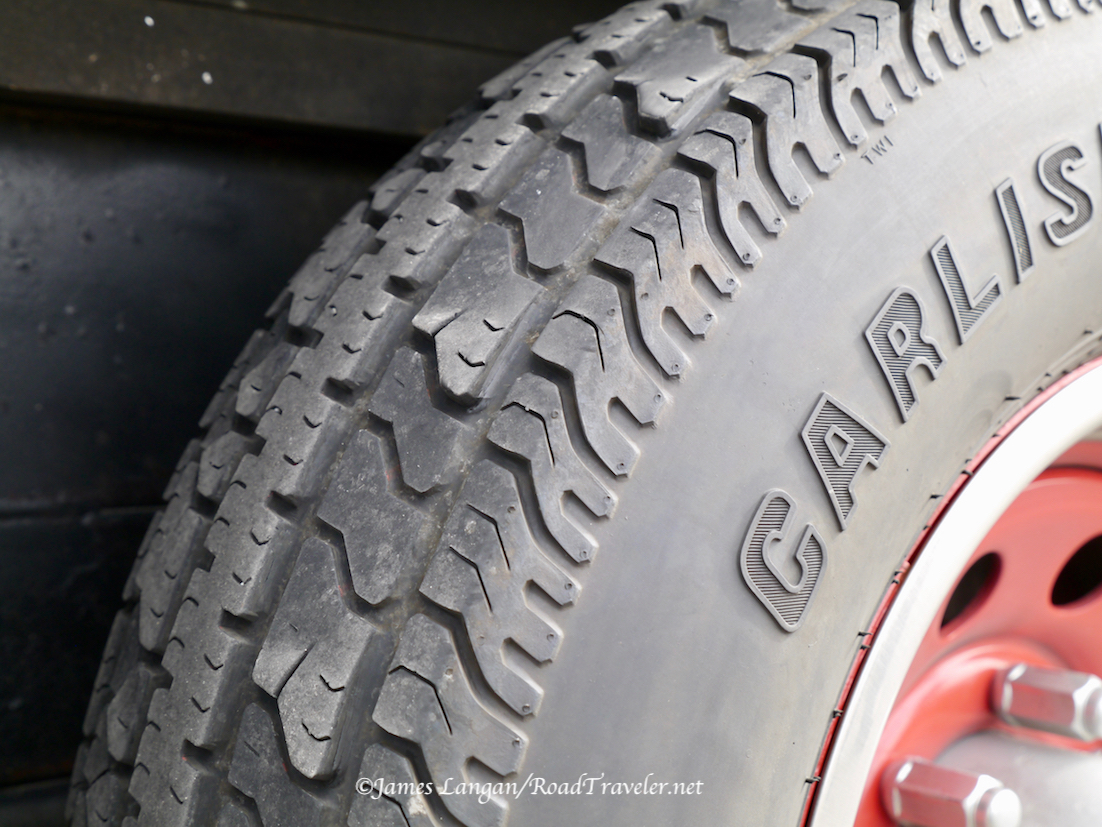
More recent sets have been radials, but cheap, offshore-made, and from a wrong-side-of-the-tracks store; often you get what you pay for. They worked, but I also didn’t drag the trailer beyond the state line for a few years, and I was less concerned about failures. I had an important trip planned to Idaho, Colorado, and back to Nevada to have my 2017 Ram’s (aka Oscar the Pack Mule) Hillsboro aluminum flatbed installed and to help design the new Hallmark flatbed camper, so I wanted to mount something better. That prompted the question, what are the best trailer tires for my application?
Special Trailer, P-metric, And Light Truck
Special Trailer (ST) tires are designed to be used on trailers, and they are not safe or legal for passenger vehicles. They are original equipment on many new trailers and are often the default choice for most at replacement time. P-metric, passenger car tires, are not specifically designed to be used on trailers, but they can be. However, their maximum load capacity must be reduced by nine-percent.
The speed rating for most ST rubber is 65 mph, though some now have higher ratings, and I purchased a set from Discount Tire a couple years ago that were capable of faster speeds. There are many states with higher speed limits without additional restrictions for trailers. Some drivers and tow-vehicles have no problem driving faster than 65 mph, but the treads need to be designed for that duty to be safe.
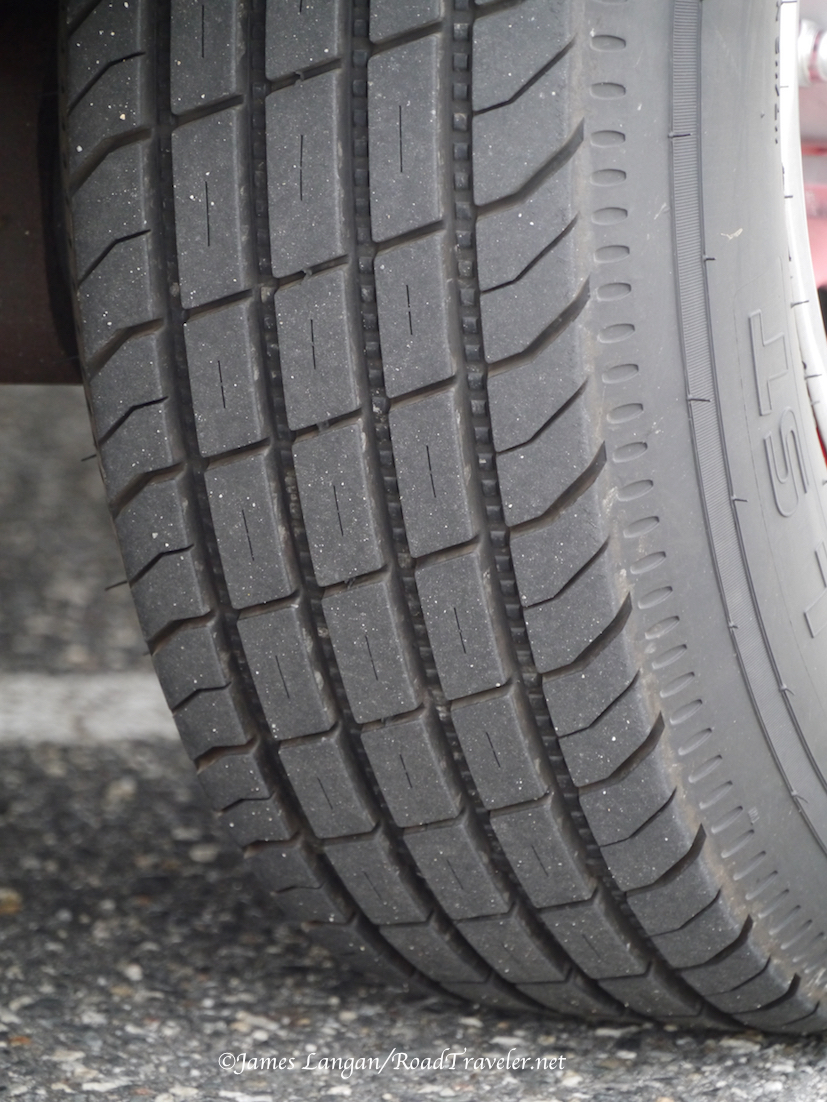
There is a sometimes-overlooked third option, Light Truck (LT) tires. Unlike P-metric sizes, LT tires can be loaded to their rated capacity for trailer applications. If you have any doubts about this, read it for yourself on a respected authority’s website: https://www.tirerack.com/tires/tiretech/techpage.jsp?techid=219
Considering LT tires not only expands the sizes that might fit a chassis, but light truck rubber can provide an additional benefit rarely seen on P-metric or ST equivalents: more tread depth. Just like it does on trucks, deeper tread helps us get more miles out of a set and can also disperse more water, snow, and other debris. Using LT tires on trailers is not revolutionary; there are a few manufacturers that put them on new units. Many RV owners unhappy with the limitations or poor quality of some ST tires have chosen to move to LT designs.
Some folks dutifully repeat hearsay that ST rubber is the only choice for trailers, primarily having P-metric in mind as the sole alternative. Instead of ST, maybe LT designs should be our go-to choice? I read a compelling argument by an RV tire expert who explained some of the ST tire shortcomings. He asked, “How is it that ST tires are rated to carry more weight than LT tires of the same size?” He explained that the loading formula for ST rubber is based on old alpha sizes, a maximum speed of 65 mph, and a shorter life expectancy. That explains a lot and doesn’t sound like a great compromise. Special Trailer tires are rated higher than comparable light truck versions partially because rapid wear (and possibly early failure) is acceptable. There are always opposing views, and I found another RV expert who acknowledged the checkered past and design limitations of ST rubber, but he still prefers them.
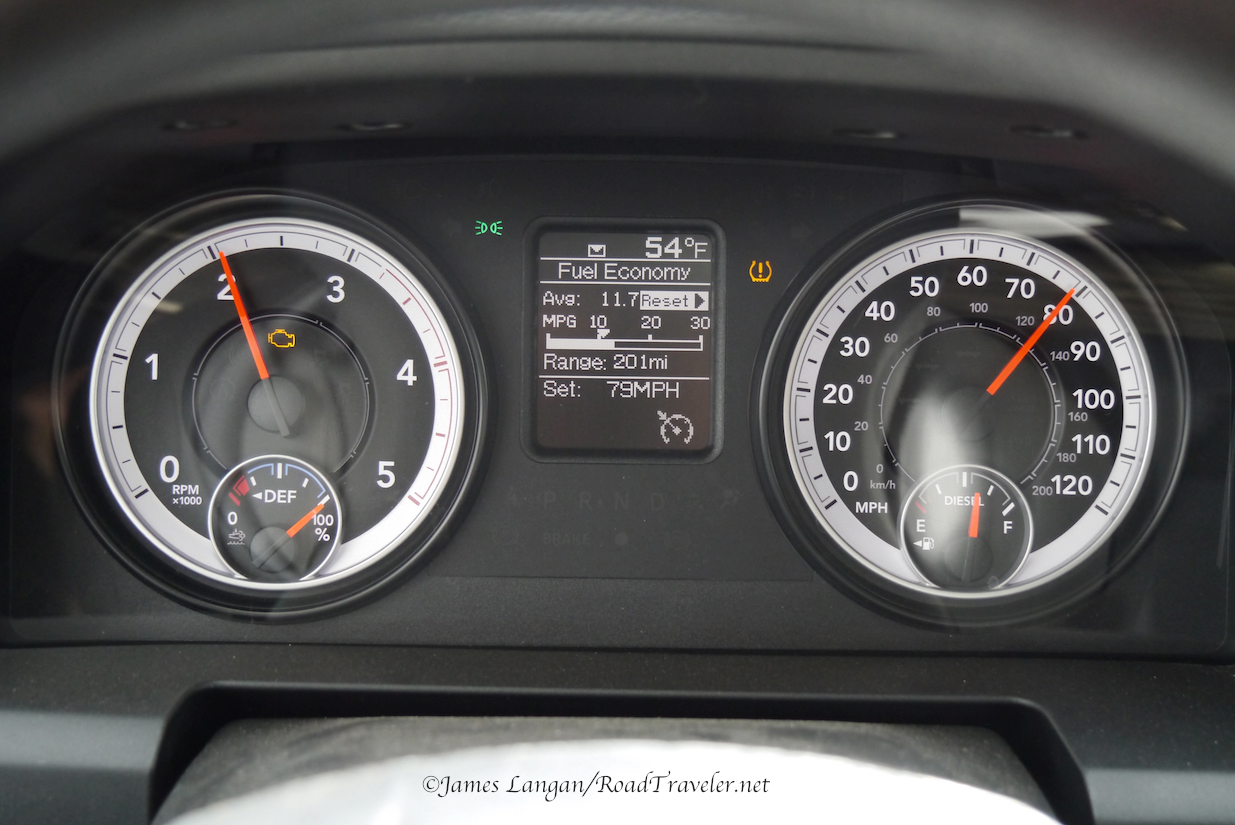
Outdated Size
The original size tires for our 40-year-old Avion trailer were 7.00-15 LT-D, which were about 29.5-inches tall. Note that this is an LT size, not an ST size, and could support 1,970-pounds each. (Modern ST versions of this exact size are rated for 2,040-pounds at 60 psi, about 70-pounds more per tire than the originals.)
Back in 1994 when we bought the Avion, the 7.00-15LT bias-ply size was still readily available. They can still be sourced but are rarely in-stock, and brand and tread choices are few. The common replacement is an ST225/75R15 radial, and a few sets of these have been run on the original Avion aluminum wheels, including load-range-C versions that had just enough load capacity.
The 225/75R15 is about one-inch shorter than the OE size, which effectively lowers the trailer about one-half inch. Some would consider a lower chassis beneficial, and generally it has been fine. However, this Avion was already pretty low, and when driving on dirt roads to deer-hunting base camps in Nevada’s Outback, lower has not been better. So I carefully researched sizes, specs, and measured the available clearance inside the Avion’s wheel wells, before jumping up to a bigger LT size.
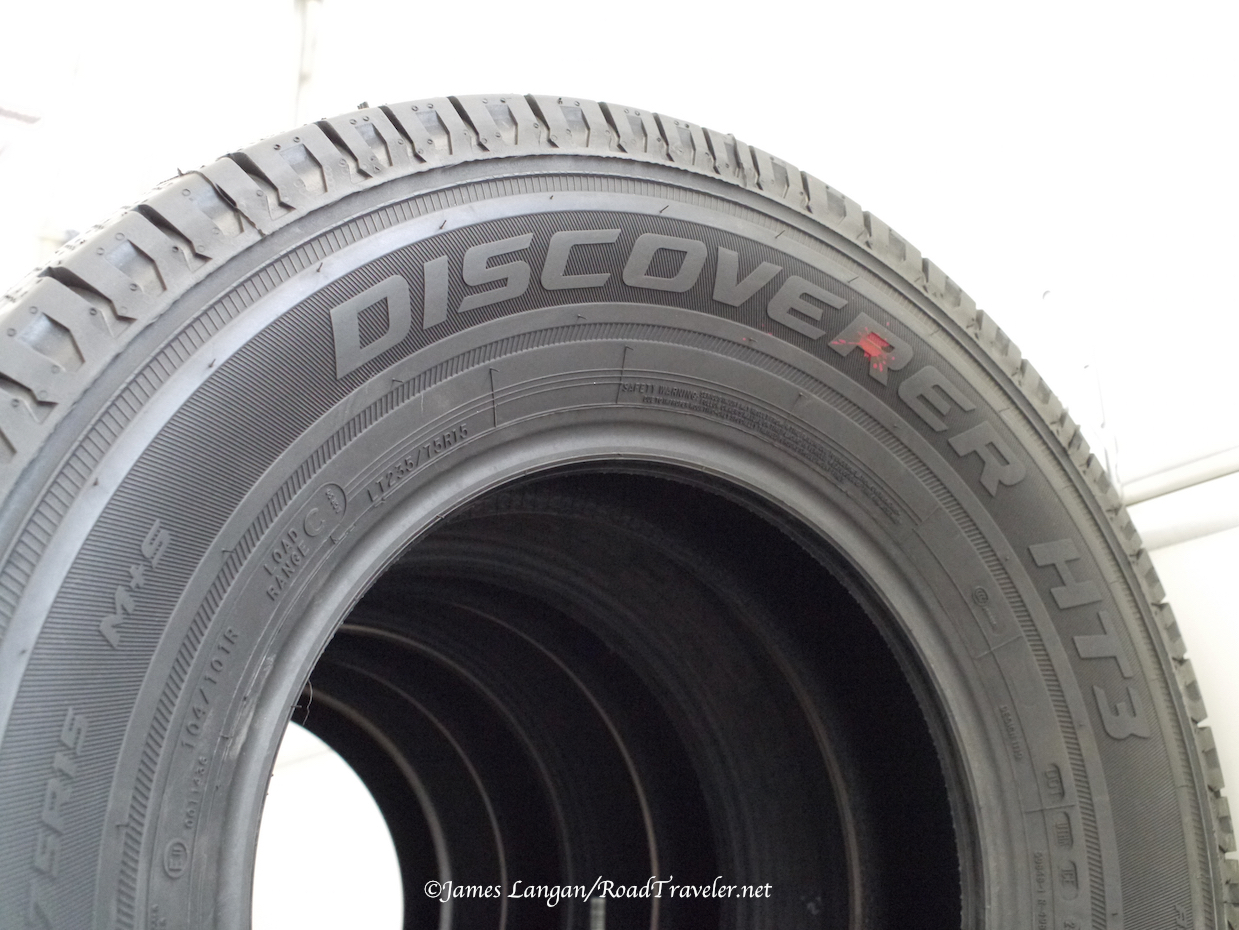
Cooper Discoverer HT3
The LT235/75R15 size is small by modern pickup standards, but they are still made and available from full-line manufacturers. The overall diameter is similar, though slightly wider and taller than the original 7.00-15LT. The exact dimensions of a tire in any given size will vary between manufacturers, and with the limited clearance on the trailer, I was concerned about possible rubbing. I measured carefully, studied the suspension and fender wells, and convinced myself that Cooper Tire’s LT235/75R15C probably would not rub ($130 each).
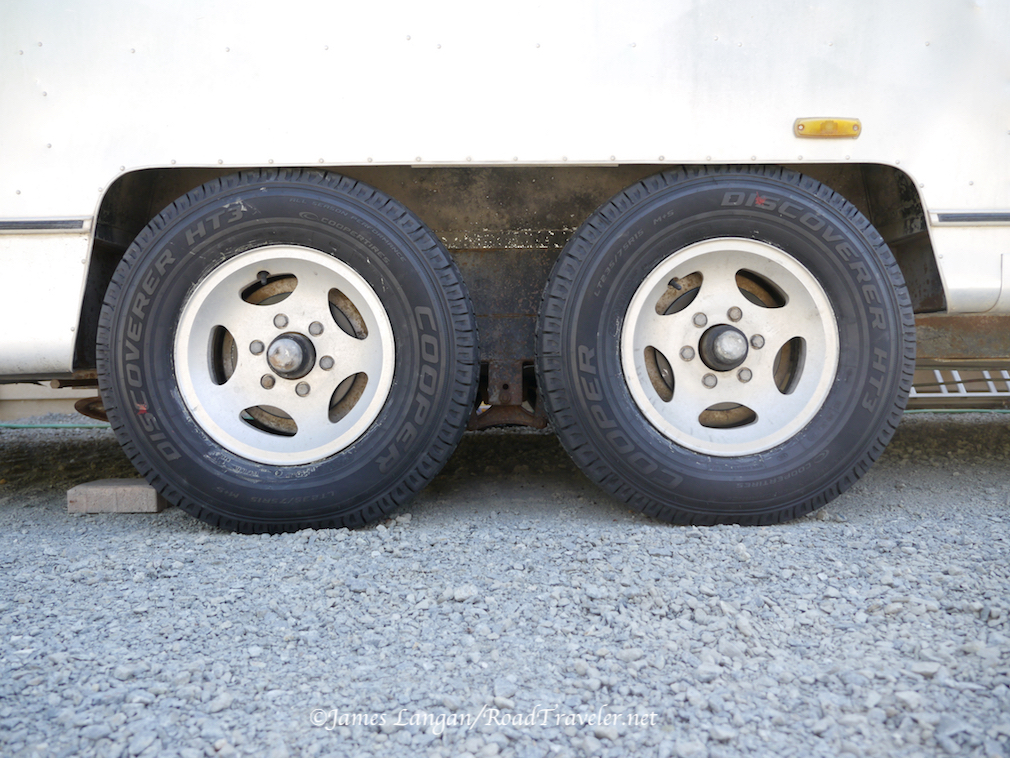
The original 7.00-15 were load-range-D, and most 235/75R15LT are load-range-C. However, as I detailed in another tire article, it is time to starting using a tire’s load index and the actual capacity, instead of load range or ply rating. What does the sidewall say? The load-range-D, 7.00-15LT treads were rated for 1,970-pounds at 60 psi. These load-range-C Cooper Discoverers in LT235/75R15 have a capacity of 1,985-pounds at 50 psi. Tread depth is a whopping 14/32”, not quite double the 8/32” on a typical ST. It should be easy to get thousands more miles out of these Coopers. Pay a little more to get more performance, wear, and safety? You bet!
The HT3s were mounted on the OE aluminum wheels, static/single plane balanced, and test fit to the Avion. The Cooper Discoverers appeared to have adequate clearance, but I went to a nearby high school parking lot after hours to articulate the axles on some large, teenager-inspired speed bumps, while inspecting for possible rubbing. With an HT3 stuffed into the fender well, clearance between the outer shoulder and the inner fender was tight, about 1/2″, but they did clear.
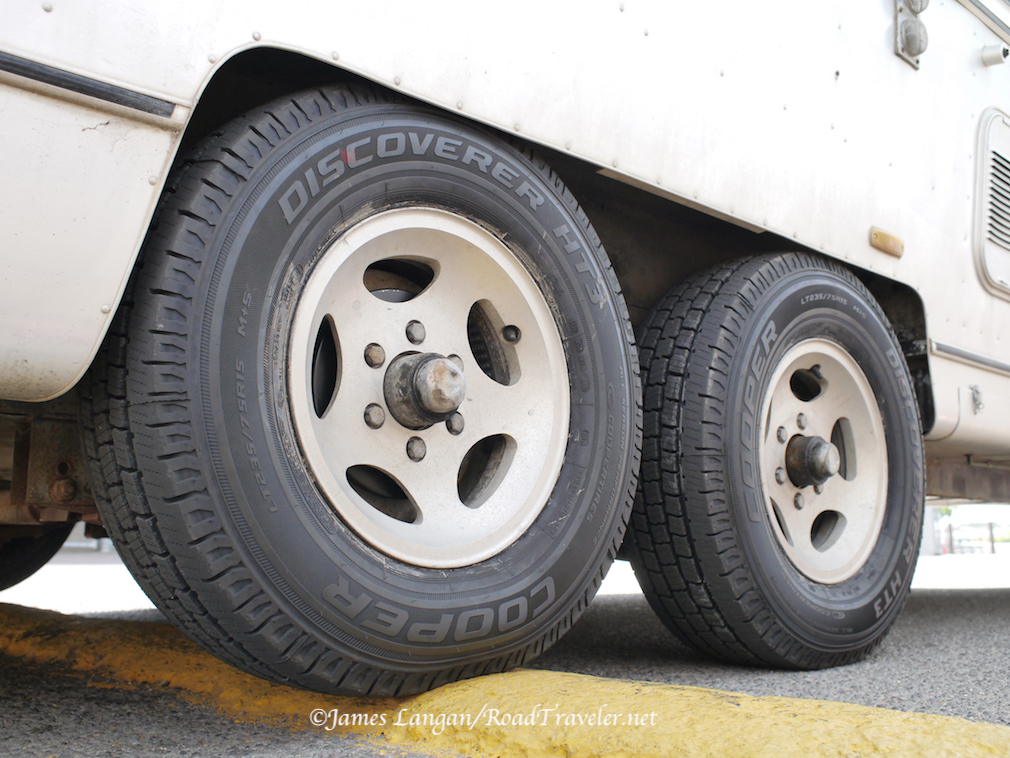
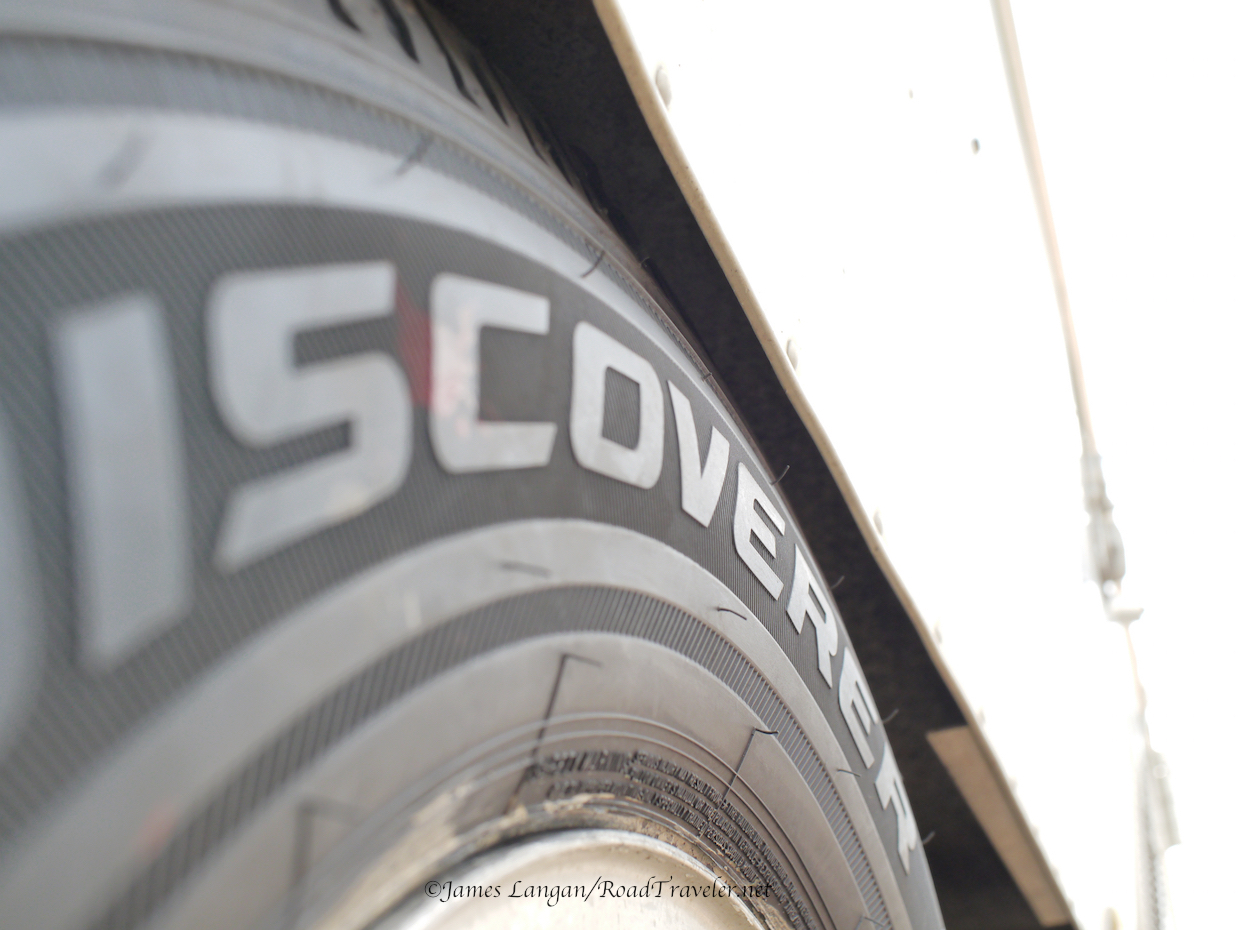
2,200 Mile Road Test
The real test was heading out across the Western United States, over fast rural highways and freeways. Leaving Western Nevada, I drove almost 500 miles to have the Pack Mule’s flatbed installed in Idaho, then another 700 miles to Fort Lupton, Colorado, to Hallmark Campers. The most direct route home was an additional 1,000 miles.
The Avion dutifully followed behind the regular cab flawlessly, at any legal speed, which is 80 mph on some sections of rural Interstate 80 in Wyoming, Utah, and Nevada. These HT3 have an N-speed-rating, 106 mph, of course that’s a bit fast, and most towing was between 65 and 75 mph.
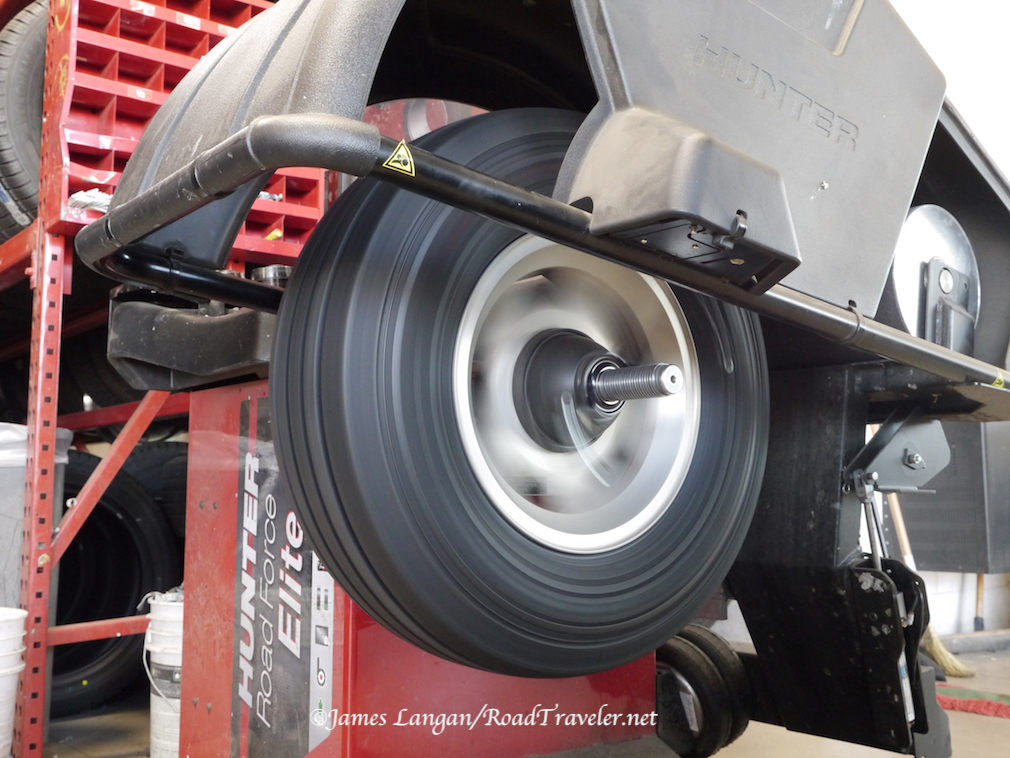
The Discoverers never felt hot to the touch, barely warm, and did not appear to wear during the trip, as they still measured a full 14/32″ upon returning home. This contrasts with the short life I’ve experienced from bias-ply tries on the same chassis, which sometimes have been consumed after just a few thousand miles. I am extremely happy that I chose the Cooper Discoverer HT3 specifically, and a high-quality LT tire in general.
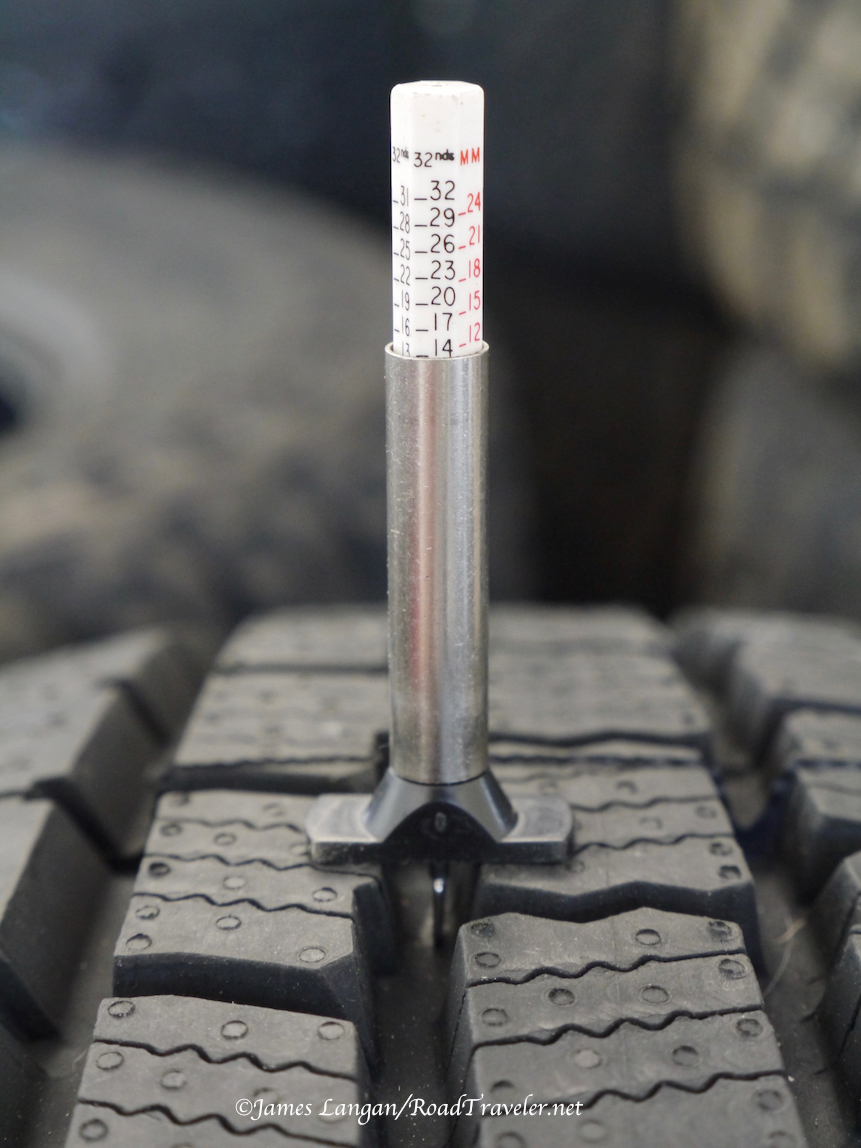
Tell ‘em you saw it on RoadTraveler.net.
James Langan
Copyright James Langan/RoadTraveler. All Rights Reserved
Resources:
Cooper Tires
800-854-6288
Hallmark Campers
877-659-5753
Tell ‘em you saw it on RoadTraveler.net.
James Langan
Copyright James Langan/RoadTraveler. All Rights Reserved
Resource: